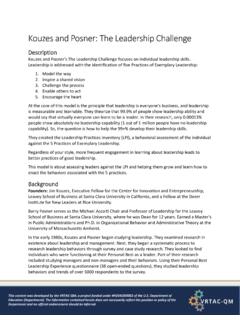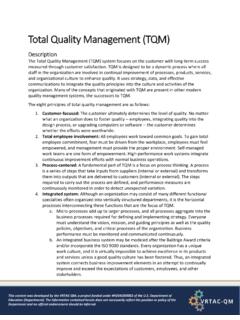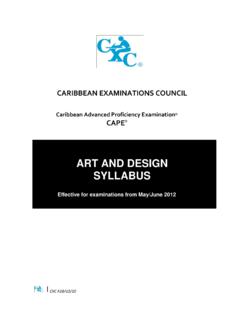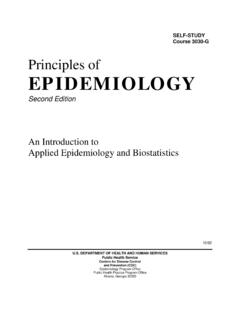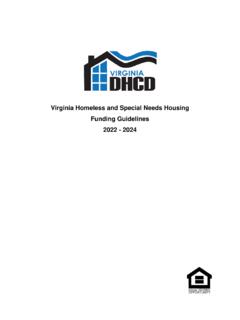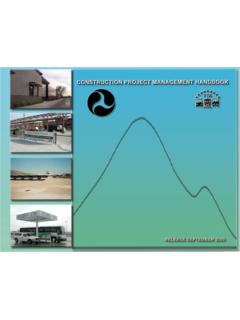Transcription of Malcolm Baldrige Criteria for Performance Excellence
1 This content was developed by the VRTAC-QM, a project funded under #H264J200002 of the Department of Education (Department). The information contained herein does not necessarily reflect the position or policy of the Department and no official endorsement should be inferred. Malcolm Baldrige Criteria for Performance Excellence Description The Malcolm Baldrige Model of Performance Excellence is a framework for organizational continuous improvement. The main values and concepts foundational to the Baldrige model include but are not limited to systems perspective, visionary leadership, customer-focused Excellence , agility and resilience, management by fact, and innovation. Applied for over 30 years, the Baldrige Excellence Framework works to empower organizations to accomplish their mission, improve results, and become more competitive. Designed to help organizations innovate and improve, the Baldrige Excellence Framework includes Criteria for Performance Excellence , core values and concepts, and guidelines to evaluating processes and results.
2 Background In the early and mid-1980s, many industry and government leaders saw the need for renewed emphasis on quality for doing business in an expanding and competitive world market. The Baldrige model was established by Congress to promote improved quality of goods and services in companies and organizations, primarily manufacturing and industry. The goal of the Malcolm Baldrige National Quality Improvement Act of 1987 (Public Law 100-107) was to enhance the competitiveness of businesses. The program and award were named for Malcolm Baldrige who served as the United States Secretary of Commerce during the Reagan administration. In 2010, the program's name was changed to the Baldrige Performance Excellence Program. Based on annual survey responses, Baldrige Award applicants have noted the following benefits: Accelerated improvement efforts: The application process itself accelerates and goes beyond internal self-assessments by bringing a rigorous, objective, external viewpoint to the organization's internal improvement process.
3 Energized employees: Pursuing a common goal motivates employees, resulting in energized improvement efforts. An outside perspective: Five to eight trained experts review each application. As a group, they spend a minimum of 300 hours reviewing each application, and site-visited applicants receive more than 1,000 hours of review. Learning from the feedback: Each applicant receives an objective, non-prescriptive written assessment of its strengths and opportunities for improvement based on an examination of its award application against the Baldrige Criteria for Performance Excellence . Organizations often use the report in their strategic planning to focus on their customers and improve results, as well as to help energize and guide improvement efforts. This content was developed by the VRTAC-QM, a project funded under #H264J200002 of the Department of Education (Department). The information contained herein does not necessarily reflect the position or policy of the Department and no official endorsement should be inferred.
4 Aligned efforts and resources: The linkages among the requirements of the seven Baldrige Criteria Categories can help organizations achieve better coordination and consistency among plans, processes, information, resource decisions, actions, results, analysis, and learning. An integrated approach to management: Management benefits from the big-picture systems perspective embedded in the integrated structure of the Baldrige core values and concepts, the Baldrige Criteria , and the scoring guidelines. This perspective helps organizations channel activities in consistent directions, ensuring unity of purpose while supporting agility, innovation, and decentralized decision making. Focus on results: Results are the bottom line in the Baldrige process: 450 of the 1,000 points in the Baldrige scoring system are allocated to results, one of seven Baldrige Criteria Categories. This results focus helps organizations determine the most critical areas to measure, create, and balance value for key stakeholders, and improve Performance in key areas such as customer engagement, process Performance , product Performance , student learning, and health care outcomes.
5 Enhanced certification and accreditation efforts: Recent iterations of standards from organizations in widely varying fields -- such as those from the International Organization for Standardization, the Joint Commission, and the North Central Association of Colleges and Schools -- are compatible with the Baldrige Criteria . In some cases, a Baldrige application may be substituted for an assessment . Role-model status and pride: Even though Baldrige Award recipients tell the Baldrige Program that applying for the Award is not about winning, they also report that their organizations and communities develop a tremendous sense of pride. Baldrige Award recipients share their stories and best Performance practices with thousands of people around the country and the world. And Baldrige Award recipients help improve the competitiveness of organizations by inspiring them to improve their Performance .
6 Since inception in 1987, the model and award that followed shortly thereafter has evolved to its current public-private partnership. Currently, a host of organizations and entities play a key role, including the following: The National Institute of Standards and Technology (NIST): A physical sciences laboratory and a non-regulatory agency of the United States Department of Commerce. Its mission is to promote innovation and industrial competitiveness. The American Society for Quality (ASQ): A knowledge-based global community of quality professionals promoting and advancing quality tools, principles , and practices in their workplaces and communities. The United States Department of Commerce: An executive department of the federal government concerned with promoting economic growth. Among its tasks are gathering economic and demographic data for business and government decision-making and helping to set industrial standards.
7 The Information Systems Security Association (ISSA): A not-for-profit, international organization of information security professionals and practitioners This content was developed by the VRTAC-QM, a project funded under #H264J200002 of the Department of Education (Department). The information contained herein does not necessarily reflect the position or policy of the Department and no official endorsement should be inferred. providing educational forums, publications, and peer interaction opportunities that enhance the knowledge, skill, and professional growth of its members. Business, Education, Healthcare, and Nonprofit experts, as a Board of Examiners: A Board of Examiners made up of leaders in the noted industries who review applications for and make determinations regarding Baldrige awards . Its scope expanded to health care and education organizations in 1999 and to nonprofit/government organizations in 2007, and in 2017, cybersecurity.
8 Congress created the Award Program for the following reasons: Identify and recognize role-model businesses. Establish a criterion for evaluating improvement efforts. Disseminate and share best practices . A Malcomb Baldrige National Quality Award established by the same legislation is awarded to organizations annually. The awards recognize national role models, who then share their best-in-class practices with other organizations. Purpose The Malcolm Baldrige Model of Performance Excellence provides a framework to help organizations focus on knowing the critical aspects of managing and performing as an organization. It builds around an integrated Performance management framework that the whole organization engages with, to improve overall Performance and strive towards Excellence . The model is guided by the following values: Unwavering Commitment to Continuous Improvement and Organizational Performance Excellence Stewardship -- accountability above reproach Trust -- through teamwork, open communication, and transparency Visionary Leadership -- focused on results and creating value How It Works Baldrige is a nonprescriptive framework and does not instruct leaders how to manage their organizations.
9 It is an adaptable model that creates an Organizational Profile from what an organization describes as important to them. Based on that profile, improvement tools are chosen that are most effective for the organization in meeting those factors of importance, to assess progress, and adapt accordingly. assessment and improvement are directed along the following dimensions: Approach: How do you accomplish your organization s work? How systematic and effective are your key approaches? This content was developed by the VRTAC-QM, a project funded under #H264J200002 of the Department of Education (Department). The information contained herein does not necessarily reflect the position or policy of the Department and no official endorsement should be inferred. Deployment: How consistently are your key approaches used in relevant parts of your organization? Learning: How well have you evaluated and improved your key approaches?
10 How well have improvements been shared? Has new knowledge led to innovation? Integration: How well do your approaches reflect your current and vision and future organizational needs? How well are processes and operations harmonized across your organization? Thereafter, the model continues in assessing the results of implemented improvement efforts along the following dimensions: Levels: What is your current Performance on a meaningful measurement scale? Trends: Are the results improving, staying the same, or getting worse? Comparisons: How does your Performance compare with that of competitors, or with benchmarks or industry leaders? Integration: Are you tracking results that are important to your organization? Are you using the results in decision making? As organizations ask and respond to these questions and assess responses, strengths and gaps are identified. The coordination of key processes and feedback between processes and results will lead to cycles of improvement.
